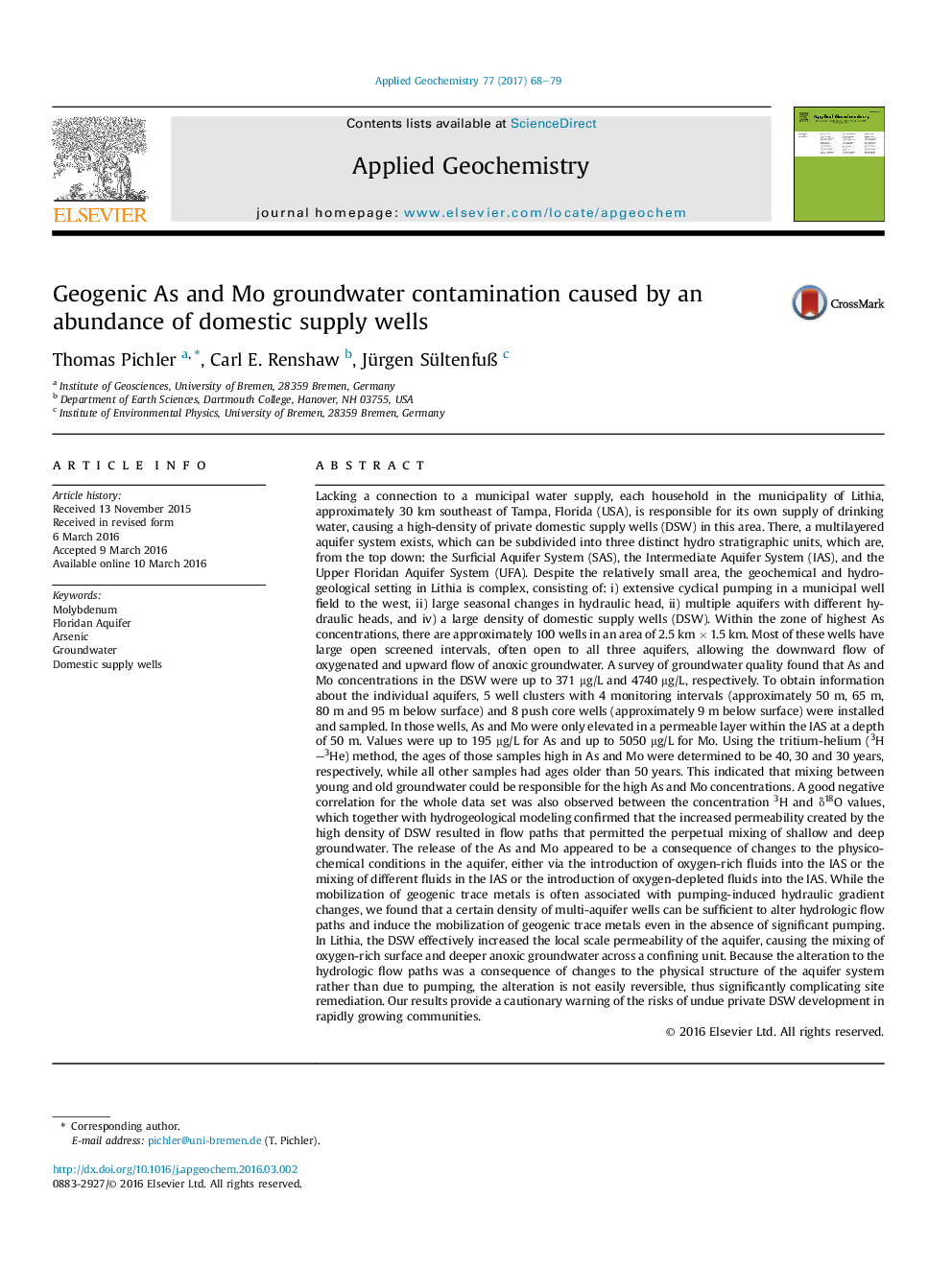| کد مقاله | کد نشریه | سال انتشار | مقاله انگلیسی | نسخه تمام متن |
|---|---|---|---|---|
| 5752489 | 1620214 | 2017 | 12 صفحه PDF | دانلود رایگان |

- Anthropogenic perturbations cause elevated As and Mo in groundwater.
- Hydraulic gradient and permeability changes due to high density of private wells.
- Powellite precipitation limits Mo concentration in carbonate aquifers.
Lacking a connection to a municipal water supply, each household in the municipality of Lithia, approximately 30 km southeast of Tampa, Florida (USA), is responsible for its own supply of drinking water, causing a high-density of private domestic supply wells (DSW) in this area. There, a multilayered aquifer system exists, which can be subdivided into three distinct hydro stratigraphic units, which are, from the top down: the Surficial Aquifer System (SAS), the Intermediate Aquifer System (IAS), and the Upper Floridan Aquifer System (UFA). Despite the relatively small area, the geochemical and hydrogeological setting in Lithia is complex, consisting of: i) extensive cyclical pumping in a municipal well field to the west, ii) large seasonal changes in hydraulic head, ii) multiple aquifers with different hydraulic heads, and iv) a large density of domestic supply wells (DSW). Within the zone of highest As concentrations, there are approximately 100 wells in an area of 2.5 km Ã 1.5 km. Most of these wells have large open screened intervals, often open to all three aquifers, allowing the downward flow of oxygenated and upward flow of anoxic groundwater. A survey of groundwater quality found that As and Mo concentrations in the DSW were up to 371 μg/L and 4740 μg/L, respectively. To obtain information about the individual aquifers, 5 well clusters with 4 monitoring intervals (approximately 50 m, 65 m, 80 m and 95 m below surface) and 8 push core wells (approximately 9 m below surface) were installed and sampled. In those wells, As and Mo were only elevated in a permeable layer within the IAS at a depth of 50 m. Values were up to 195 μg/L for As and up to 5050 μg/L for Mo. Using the tritium-helium (3H-3He) method, the ages of those samples high in As and Mo were determined to be 40, 30 and 30 years, respectively, while all other samples had ages older than 50 years. This indicated that mixing between young and old groundwater could be responsible for the high As and Mo concentrations. A good negative correlation for the whole data set was also observed between the concentration 3H and δ18O values, which together with hydrogeological modeling confirmed that the increased permeability created by the high density of DSW resulted in flow paths that permitted the perpetual mixing of shallow and deep groundwater. The release of the As and Mo appeared to be a consequence of changes to the physicochemical conditions in the aquifer, either via the introduction of oxygen-rich fluids into the IAS or the mixing of different fluids in the IAS or the introduction of oxygen-depleted fluids into the IAS. While the mobilization of geogenic trace metals is often associated with pumping-induced hydraulic gradient changes, we found that a certain density of multi-aquifer wells can be sufficient to alter hydrologic flow paths and induce the mobilization of geogenic trace metals even in the absence of significant pumping. In Lithia, the DSW effectively increased the local scale permeability of the aquifer, causing the mixing of oxygen-rich surface and deeper anoxic groundwater across a confining unit. Because the alteration to the hydrologic flow paths was a consequence of changes to the physical structure of the aquifer system rather than due to pumping, the alteration is not easily reversible, thus significantly complicating site remediation. Our results provide a cautionary warning of the risks of undue private DSW development in rapidly growing communities.
236
Journal: Applied Geochemistry - Volume 77, February 2017, Pages 68-79